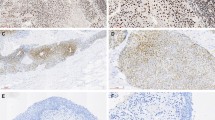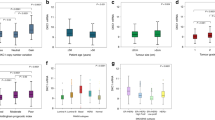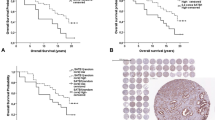Abstract
The predictive value of silver stained nucleolar organiser regions (AgNORs) was assessed in 229 patients with transitional cell bladder cancer followed up for over 10 years. The AgNORs were enumerated in pretreatment biopsy specimens. The AgNORs were related to clinical stage (T) (P = 0.0111), papillarity (P less than 0.0001), WHO grade (P less than 0.0001), DNA ploidy (P = 0.0010) and S-phase fraction (P less than 0.0001). Tumours presenting with pelvic lymph node involvement (P = 0.0085) or metastasis (P = 0.0780) at the time of diagnosis had more AgNORs than tumours confined to the bladder wall. Progression in T-, N- and M-categories (P = 0.0010-0.0030) was related to AgNORs and consequently they predicted bladder cancer related survival (P = 0.0005). The diploid tumours could be regrouped according to survival by AgNORs (P = 0.0001). In papillary tumours AgNORs predicted progression (P = 0.0110) and survival (P = 0.0038). In Ta-T1 tumours AgNORs predicted progression (P = 0.11) and survival (P = 0.0751) and also in T2-T3 tumours AgNORs contributed to survival significantly (P = 0.0039). The AgNORs subdivided WHO grade III tumours according to their ability to progress during the follow-up time (P = 0.0711). In a multivariate analysis AgNORs predicted progression independently in Ta-T1 category (P = 0.0165). AgNORs predicted recurrence free period like SPF (P = 0.0010). In conclusion, AgNORs are inferior to classic prognostic factors or DNA flow cytometric variables in muscle invasive bladder cancers whereas they have independent predictive value in superficial cancers.
This is a preview of subscription content, access via your institution
Access options
Subscribe to this journal
Receive 24 print issues and online access
$259.00 per year
only $10.79 per issue
Buy this article
- Purchase on Springer Link
- Instant access to full article PDF
Prices may be subject to local taxes which are calculated during checkout
Similar content being viewed by others
Author information
Authors and Affiliations
Rights and permissions
About this article
Cite this article
Lipponen, P., Eskelinen, M. & Nordling, S. Nucleolar organiser regions (AgNORs) as predictors in transitional cell bladder cancer. Br J Cancer 64, 1139–1144 (1991). https://doi.org/10.1038/bjc.1991.478
Issue Date:
DOI: https://doi.org/10.1038/bjc.1991.478
This article is cited by
-
Markersysteme beim Harnblasenkarzinom
Der Urologe B (1997)
-
Predictive value of argyrophilic nucleolar-organizer-region-associated proteins in bladder cancer, using cell-imprint preparations
Journal of Cancer Research and Clinical Oncology (1997)
-
Expression and prognostic value of proliferating cell nuclear antigen in transitional cell carcinoma of the urinary bladder
Urological Research (1997)
-
Expression of MIB-1, mitotic index and S-phase fraction as indicators of cell proliferation in suerficial bladder cancer
Urological Research (1996)
-
Validation of silver-stained nucleolar organizer regions for evaluation of invasive character of urinary bladder carcinoma in rats and mice
Urological Research (1995)



